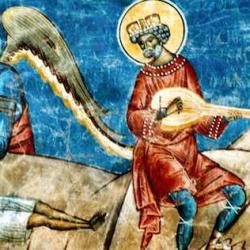Keil and Delitzsch point out that Psalm 110 is structured as three sets of seven clauses. Each of these sets of seven consists of a “tetrastich together with a tristich.” These three sets are verses 1-2, verses 3-4, and verses 5-7.
Verse 1 is the first tetrastich (Lord says; Sit; Until I make enemies; footstool for Your feet), followed by the tristich of verse 2 (Heb order: scepter of power; Yahweh will stretch from Zion; rule in midst). The second cycle begins with the tetrastich of verse 3 (Thy people volunteer; in holy array; from womb; youth like dew), and the tristich begins with the name Yahweh (Yahweh swears; not turn back; priest forever). The final set of seven is the most clear in English translations, but the division of tetrastich and tristich is less clear. The whole section begins with the third use of the name Yahweh (v 5), and the beginning of the tristich is marked by the repetition of the verb “shatter.”
The heptamerous structure is a general reference back to the creation week, but perhaps there are more extended connections with the days of creation. The first and the last sequence ends with an emphasis on sabbatical rule and exaltation: “Rule in the midst of Thine enemies” and “He will lift up the head.” And, if we consider Hebrews’ interpretation of the Melchizedekan priesthood, which emphasizes that the priest is seated rather than standing, the middle section may also end on a sabbatical note. The first clause of each section may also contain an allusion to the first day of creation. The Psalm opens with the speech of Yahweh, and the first clause of the section section begins with a reference to the “day” (v 3). Verse 5, which begins the final sequence, clearly refers back to the proclamation of verse 1. This suggests the possibility that other stiches would match up with the creation week. The central (4th day) clause in the second sequence, for instance, refers to youth like the dew, an image that may be related to imagery of rule (cf. 2 Sam 23:4). There may well be others. There may not.















